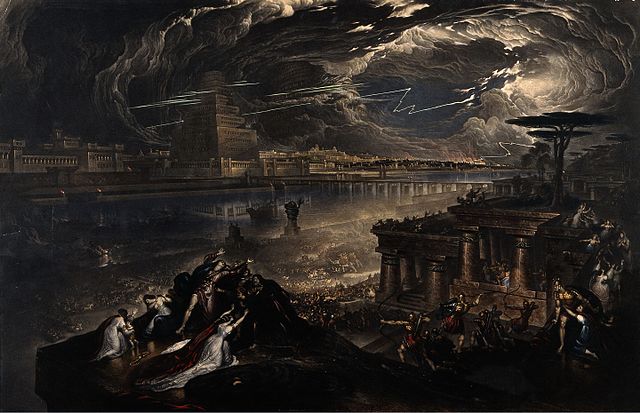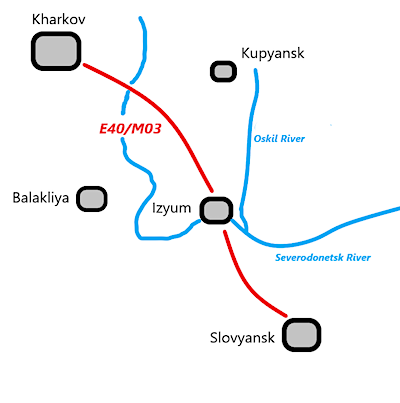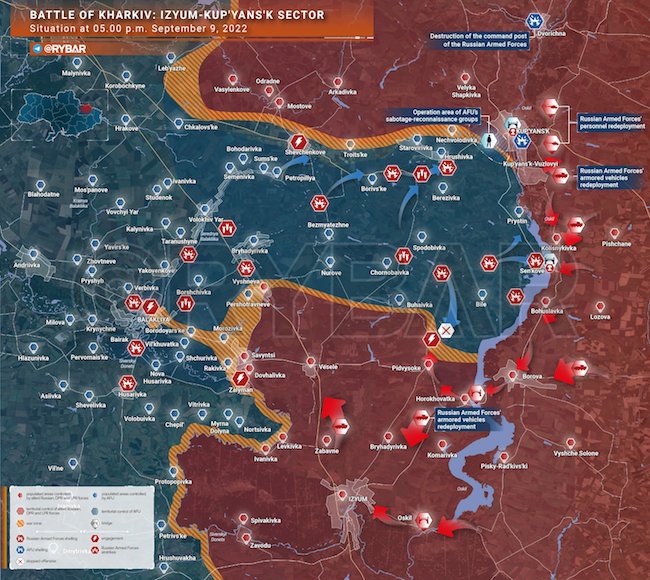
John Martin The Fall of Babylon 1831

The Ukraine “war” narrative is changing. From the west/Kiev side, that is. They are trying to get Wall Street capital involved. Zelensky attempts to sell them parts of Ukraine that are not his to sell in practice, because he doesn’t control them, but that are according to US law, a country 10,000 miles away or so. Russia recognized Crimea as part of its territory 8 years ago after a referendum in which 95% of citizens voted for that move, but the west never has. The Donbass republics declared their independence at the same time, but Russia only acknowledged that one day before their Special Military Operation (SMO). A feast for lawyers. And a nightmare.
Ukraine has made some headway in what is labeled a “counterattack” -but which could simply be a trap-, and anyway -“Kiev has banned journalists from the front lines, making these claims difficult to verify”- and this is milked for all it can deliver, and then some. Beware. First up, there’s a retired US general declaring Russia has all but lost:
Ukraine Will Retake Crimea In A Year – Ex-US General
Ukraine could “restore full sovereignty” within a year, retaking all of its lost territory including Crimea, retired US General Ben Hodges told Newsweek on Thursday at the Tbilisi International Conference of the McCain Institute in Georgia. Hodges is now a lobbyist at the Centre for European Policy Analysis, a pressure group funded by NATO and US arms manufacturers. Western support for Kiev has resulted in a financial bonanza for these companies. “The Ukrainians saved their country,” Hodges gushed, declaring that “half a year after the start of the full-scale Russian invasion…the supposed second-best army in the world is now the second-best army in Ukraine,” with Russia’s “ability to conduct further offensive operations…all but exhausted.”
Now, Hodges said, it was up to the US and NATO to step in and make sure the war is won, starting with a full-throated proclamation of support for Kiev. Washington should stop publicizing the cost of the military aid it sends overseas, he continued, suggesting the deliveries be framed in terms of the percentage of “what is needed for Ukraine to defeat Russia and regain their territory.” The retired general did not elaborate on how those numbers could be calculated. The administration of US President Joe Biden has poured over $44 billion into the war effort since February. While Ukraine and its Western backers have declared the Kherson counteroffensive a rousing success, boasting of recapturing several villages, Kiev has banned journalists from the front lines, making these claims difficult to verify.
Russia has argued the initiative “failed miserably,” pointing to the loss of over 1,200 Ukrainian servicemen in a single day of fighting. Ukrainian MP Alexey Goncharenko echoed Hodges’ optimism in comments to Newsweek, declaring “next year will be the decisive year of the war” and that “with the help of the free world, Ukraine has an opportunity to win.” That will require a lot more weapons, he clarified, mentioning aircraft, air defense systems, and rockets superior to the HIMARS. Crimea became part of Russia in the wake of a 2014 referendum following the US-backed overthrow of the democratically-elected government of Viktor Yanukovich in Kiev.
Ukraine and NATO consider it illegally annexed territory, and the US has reportedly given Ukrainian President Vladimir Zelensky the go-ahead to attack the peninsula. The Donbass republics of Donetsk and Lugansk declared their independence that same year and were recognized as independent states by the Kremlin this past February. Zelensky has vowed to retake all three regions, promising on Sunday that “Ukraine will return” to Donbass, Kharkov, Zhaporozhye, Kherson, and “definitely to Crimea.”
Then a Ukraine general claims Russia is about to use nukes, again because it allegedly has all but lost. Please note that Ukraine has no nukes, so how this fine young man could see a “limited” nuclear war is not clear, unless he’s calling for US (or French, or UK) nukes to get involved. Mind you, it simply looks like another attempt to get the west to send ever more and ever heavier weapons, so the Ukraine can get more Ukrainians killed. But nukes are never a joke, no matter how ridiculous the claims made.
Ukraine’s Top General Doesn’t Rule Out “Limited” Nuclear War
Ukraine’s top military chief has warned that Russia could unleash nukes if its army is against the ropes in Ukraine. The comments were issued Wednesday amid an ongoing Ukrainian counteroffensive in the south and east which both Kiev and Washington say has so far had “success”. Commander-in-Chief of the Armed Forces Gen. Valery Zaluzhny stated “There is a direct threat of the use, under certain circumstances, of tactical nuclear weapons by the Russian armed forces.” He wrote this in an op-ed published by state run outlet Ukrinform, with the alarming words being picked up by The Washington Post and others. “It is also impossible to completely rule out the possibility of the direct involvement of the world’s leading countries in a ‘limited’ nuclear conflict, in which the prospect of World War III is already directly visible,” Zaluzhny added.
The top commander further issued his first official confirmation that the unprecedented large strikes on Russia’s Crimea bases and an arms depot widely reported in August were Ukrainian operations. The initial early August huge Saki air base explosion had previously only been acknowledged as a Ukrainian strike via anonymous leaks to Western media outlets by senior Kiev officials. At around the same time as those opening Crimea attacks, which have continued sporadically since then, President Zelensky vowed to “liberate” the Russian-held territory, which the Kremlin gained control of after a 2014 popular referendum, which wasn’t recognized by Europe or the US. According to Gen. Zaluzhny’s words as featured in The Washington Post:
“With the fighting all but certain to continue into 2023, Ukraine has to make the war “even sharper and more tangible for the Russians and for other occupied regions, despite the massive distance to the targets,” Zaluzhny wrote. He called the Crimean strikes a “convincing example” of Kyiv’s calls for allies to send longer-range weapons for its outgunned soldiers.. Moscow, he said, can hit 20 times farther.” Moscow for its part has also expressed alarm over the potential for nuclear-armed confrontation with the West over Ukraine, given Washington’s steadily growing involvement – especially the billions of dollars in weapons and military aid being poured into the Ukrainian side. It has also rejected charges that it is prepared to use nukes.
The next article is crucial to our understanding of what is going on. Zelensky is trying to sell his country to the highest bidder, to the last inch.. That’s been going on for a while. A lot of land and industry has already been sold. But be careful here: Zelensky is also selling off “assets” that are nominally his, but which he doesn’t control. Like the Crimea, like the Donbass – Ukraine’s only real fertile and industrious region-.
Both are -largely- under Russian control, but the west doesn’t formally recognize that. 8 years after a referendum won by 95%, the west still insists that Crimea is not Russian. So Ze can sell it, more or less legally, and if a potential buyer points out the Russian control, he’ll say he’s about to regain control (a retired US general said so himself) and you can have a discount for the risk (half price!). But then if the Russians advance -which they will-, they’re now advancing on western -Wall Street- property, not Ukrainian. And then Blackrock et al will lean on DC to bring in US troops, and eventually, nukes.
Meanwhile, Ze sounds like a sales brochure (via Benjamin Norton) :
Zelensky Is Literally Selling Ukraine To Wall Street Corporations
Ukraine’s Western-backed leader Volodymyr Zelensky virtually opened the New York Stock Exchange on the morning of September 6, symbolically ringing the bell via video stream. Zelensky announced that his country is “open for business” – that is to say, that foreign corporations are free to come and exploit its plentiful resources and low-paid labor. In a speech launching the neoliberal selloff program Advantage Ukraine, Zelensky offered Wall Street “a chance for you to invest now in projects worth of hundreds of billions of dollars.” The financial news service Business Wire published a press release from the Ukrainian government in which Zelensky boasted:
“The $400+ [billion] in investment options featured on AdvantageUkraine.com span public private partnerships, privatization and private ventures. A USAID-supported project team of investment bankers and researchers appointed by Ukraine’s Ministry of Economy will work with businesses interested in investing.” It also quoted the president of NYSE Group, Lynn Martin, who said: “As the largest exchange globally, we stand for freedom, investor protection and unfettered access to capital. We are pleased to welcome President Zelenskyy virtually to the NYSE bell podium, a symbol of the freedom and opportunity our U.S. capital markets have enabled around the globe. We are honored the President has chosen the NYSE to mark the kickoff of Advantage Ukraine and engage with the world’s business community.”
The press release cited executives of US corporate giants Google, Alphabet, and Microsoft, who salivated over the economic possibilities offered by Ukraine. Reuters noted that the Ukrainian government hired British public relations firm WPP to run the marketing operation for Advantage Ukraine. Zelensky coordinated his New York Stock Exchange publicity stunt with an editorial in the Wall Street Journal imploring US capitalists to “Invest in the Future of Ukraine.” “I committed my administration to creating a favorable environment for investment that would make Ukraine the greatest growth opportunity in Europe since the end of World War II,” Zelensky wrote. He continued:
“To create a safe, transparent environment for business engagement, Ukraine is pursuing investment guarantees from both the Group of Seven and the European Union, reforming the country’s tax system, and establishing a strong new legal framework. Our country has already adopted rules and laws to allow companies to build transparent corporate structures, attract foreign investment more easily, and use additional mechanisms to protect intangible assets. Favorable conditions will allow us to establish Ukraine as a powerful IT hub and implement innovative business ideas quickly and effectively.”.
About that alleged counterattack you -and investors- are being sold. Big Serge breaks that down. Izyum is pivotal. Russia took it very early in the SMO. “..they are attempting a thrust toward Kupyansk, with the aim of cutting the line connecting Izyum to Belgorod in the north. This operation, I believe, is doomed to spectacular failure.”
This looks like a trap. And Big Serge thinks it’s not even a prepared or planned trap, just one the Ukraine forces created themselves. And one that the Russians will be sure to “trap shut”, turning it from a “salient” into a “cauldron”. Let the Ukrainians think they are winning, let them all come in. And then close the trap.
Ukraine Counterattacks! Please Remain Calm
A modest city with a prewar population of perhaps 50,000 people, Izyum was always slated to be a focal point in this war, due to its location at a critical intersection. The topography of northeastern Ukraine is dominated by a few critically important features which determine patterns of movement. These include the crucial E40/M03 highway, which connects the metropolis of Kharkov and the urban agglomeration of Slovyansk and Kramatorsk, which are the largest and most important cities in the western Donbas. The region is furthermore shaped by the Severodonetsk River – alternatively called simply the Donets (from which the Donbas, or Donets Basin, draws its name) – which snakes lazily around the plain.
The Donets forms a geographic barrier between the Donbas to the south and the Kharkov region to the north, while the E40/M03 highway forms the main arterial for transit between Kharkov and the urban centers of the western Donbas. Izyum is a strategically crucial city because it is where the highway crosses the river; as an added cherry on top, the Oskil River – a major tributary of the Donets – confluences with the Donets less than five miles to the east of Izyum, meaning the city essentially sits directly on the intersection of all the most important geographic features of the region. A highly simplified map of the area looks like this:

Capturing Izyum was a major objective for Russia in the early weeks of the war (as I argued in a previous piece, this was a major reason for the pinning move on Kiev), because it not only interdicts and complicates supply to Ukrainian forces in the Donbas, but it also gave Russia an early position on the Donets river. It is obvious why Ukraine would want to dislodge Russia from Izyum. This would simplify and secure lines of communication to Slovyansk and greatly complicate the Russian push in the Donbas by freeing Ukraine’s northern flank. To achieve this, they are attempting a thrust toward Kupyansk, with the aim of cutting the line connecting Izyum to Belgorod in the north. This operation, I believe, is doomed to spectacular failure.
Yes, Ukraine forces advanced somewhat. But look where it’s gotten them. What “president” would do this to his own people? Sure, he has to claim they’re winning, or the Pentagon and the investors won’t show up, but how many Ukrainians will be left in the end? Blackrock doesn’t care, but a president should.
In military parlance, a “salient” simply means a bulge in the frontline, where one side has achieved some level of penetration at a particular point. A salient is a classically vulnerable position – a glaringly obvious operational focal point, because simultaneous attacks at the base of the bulge can easily cut it off and trap the forces inside. Essentially, a salient is a position where a force is already encircled on 3 sides, leaving only the exit to be snapped shut. In the opening phase of the war, Izyum was indeed a salient. Russia had captured an exposed position which jutted out into Ukrainian territory, and there was talk of a Ukrainian counteroffensive to take advantage of this. Furthermore, the only safe supply line to Izyum ran through Kupyansk, making this a vulnerable position indeed. However, throughout the following weeks, Russia took control of the territory directly to the east of Izyum, including the town of Lyman.
This concretized the Russian flank and secured additional lines of communication into Izyum, creating redundancies for the highway from Kupyansk. The window of opportunity for an easy encirclement or interdiction of supply to Izyum ended when Russia cleared all the Ukrainian forces from the north side of the Donets river. Supply lines to Izyum are now shielded from the south by the Donets, and from the west by the Oskil. Because Russia has redundant supply lines to the northeast of Izyum, for Ukraine to reach operational depth, they must cross the Donets and Oskil rivers. Even suppressing Kupyansk is not enough to disrupt Russia’s ability to project force here. The Oskil river – which, incidentally is more than a kilometer wide in places – presents a major barrier that will prevent Ukraine from exploiting their early advances. They have more or less advanced into a wall, and already the map presents an unfolding catastrophe for them. Courtesy of Rybar:

“This is a Salient with Ukrainians inside”
In short, the Ukrainian advance has been too slow and lacks a clear path to reach operational objectives. Already, Russia has begun to deploy huge reserves to this theater, and fear is beginning to show among the more operationally aware Ukrainians. One Ukrainian journalist at the front had this to say: “There is heavy fighting near Kupyansk, worse than Balakleysky. We are taking heavy losses. The enemy is transferring a bunch of reserves by air. The “Wagnerites” have already arrived in the city itself. The sky is filled with aircraft. Hearing about all this, a haunting feeling of an ambush arises in the soul. What if this all really turns out to be a strategic level ambush?”
I do not believe this is an “ambush” per se by the Russian army. The word ambush implies that the Russian forces were already in position, drawing the Ukrainians into a specific maneuver plan where they could be attacked from prepared positions. That’s not what’s happening at all – Russian forces are coming in fresh from reserve and were not pre-deployed to the sector. What the operation reflects instead is Russia’s preference to wage a high-firepower, mobile defense. Frontline positions are, relatively speaking, thinly manned, which powerful mobile reserves are held back. This is a flexible, firefighting approach which allows the Ukrainians to advance into vulnerable positions so that they can be destroyed.
Assuming that Russia is losing today due to a few Ukrainian moves also means assuming that Russia’s army is severely weak and weakened, and its commanders are mentally challenged. And there are no indications of either. But if Zelensky and the US State Dept. want to sell this war to Wall Street, they are obliged to make such claims.
What they should all be doing, of course, is talk peace. But there’s no money inn peace. At least not short term. So Europeans this winter can go to food and energy hell, courtesy of Wall Street, Biden’s neocons and a two-bit comedian, while Europe itself lacks all leadership. What a world.

We try to run the Automatic Earth on donations. Since ad revenue has collapsed, you are now not just a reader, but an integral part of the process that builds this site. Thank you for your support.

Support the Automatic Earth in virustime with Paypal, Bitcoin and Patreon.








